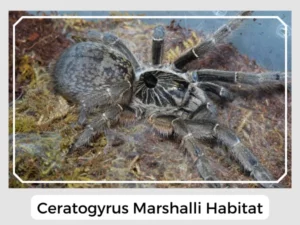The Ceratogyrus is a special group of spiders in the tarantula family. They call southern Africa their home. As of February 2019, there are about ten different types of these spiders. Stick with us to find out cool things about them!
A single sac may contain about 100-120 eggs, which are jealously guarded by the females.
They stay with their mother for a while after maturation and then disperse to be on their own.
They do make webs, some of which are hammock-styled, though detailed information is available about the same.
Yes, Ceratogyrus tarantulas have venom. But for most people, it’s not too strong. They use it mainly to snatch up and eat their meals.
Ceratogyrus tarantulas can bite if they feel threatened. While the bite might be a bit uncomfortable, it’s typically not something that causes big issues except localized pain, swelling, and other mild symptoms.
The Ceratogyrus tarantulas play a crucial role in their ecosystems, acting as both predators and prey. Their hunting activities help control the populations of various insect species, contributing to ecological balance. Characteristically, these tarantulas are burrowers, creating intricate living spaces that also contribute to soil aeration.
Natural Predators: Despite their venomous nature, Ceratogyrus tarantulas face threats from natural predators such as larger mammals, birds, and other larger arachnids. These interactions underscore the dynamic nature of their ecosystems.
Prey-Predator Dynamics: In their role as predators, Ceratogyrus tarantulas influence the population and behavior of their insect prey, while their status as prey to larger animals highlights their integral place in the food web.
Relationship with Humans: Ceratogyrus tarantulas, like many other tarantula species, have garnered interest in the pet trade. Their unique appearance, especially the characteristic horn, makes them a sought-after species for arachnid enthusiasts. While they generally pose no significant threat to humans, understanding and respecting their space and natural behaviors is crucial for a harmonious coexistence.
| Lifespan | Males: Approximately 4 years; Females: About 15 years |
| Distribution | Throughout southern Africa |
| Habitat | Mostly in burrows |
| Diet | Different types of insects |

In summary, the Ceratogyrus genus of tarantulas stands out in the arachnid world with its distinctive physical characteristics, intriguing behaviors, and integral role in the ecosystem.
The Ceratogyrus is a special group of spiders in the tarantula family. They call southern Africa their home. As of February 2019, there are about ten different types of these spiders. Stick with us to find out cool things about them!
A single sac may contain about 100-120 eggs, which are jealously guarded by the females.
They stay with their mother for a while after maturation and then disperse to be on their own.
They do make webs, some of which are hammock-styled, though detailed information is available about the same.
Yes, Ceratogyrus tarantulas have venom. But for most people, it’s not too strong. They use it mainly to snatch up and eat their meals.
Ceratogyrus tarantulas can bite if they feel threatened. While the bite might be a bit uncomfortable, it’s typically not something that causes big issues except localized pain, swelling, and other mild symptoms.
The Ceratogyrus tarantulas play a crucial role in their ecosystems, acting as both predators and prey. Their hunting activities help control the populations of various insect species, contributing to ecological balance. Characteristically, these tarantulas are burrowers, creating intricate living spaces that also contribute to soil aeration.
Natural Predators: Despite their venomous nature, Ceratogyrus tarantulas face threats from natural predators such as larger mammals, birds, and other larger arachnids. These interactions underscore the dynamic nature of their ecosystems.
Prey-Predator Dynamics: In their role as predators, Ceratogyrus tarantulas influence the population and behavior of their insect prey, while their status as prey to larger animals highlights their integral place in the food web.
Relationship with Humans: Ceratogyrus tarantulas, like many other tarantula species, have garnered interest in the pet trade. Their unique appearance, especially the characteristic horn, makes them a sought-after species for arachnid enthusiasts. While they generally pose no significant threat to humans, understanding and respecting their space and natural behaviors is crucial for a harmonious coexistence.
| Lifespan | Males: Approximately 4 years; Females: About 15 years |
| Distribution | Throughout southern Africa |
| Habitat | Mostly in burrows |
| Diet | Different types of insects |

In summary, the Ceratogyrus genus of tarantulas stands out in the arachnid world with its distinctive physical characteristics, intriguing behaviors, and integral role in the ecosystem.